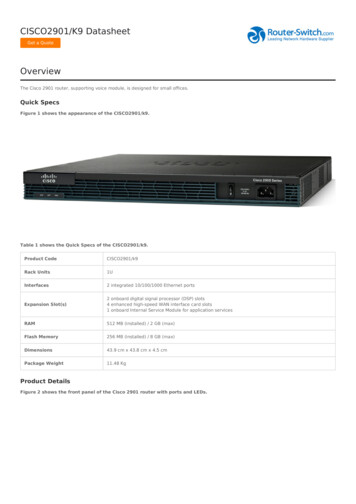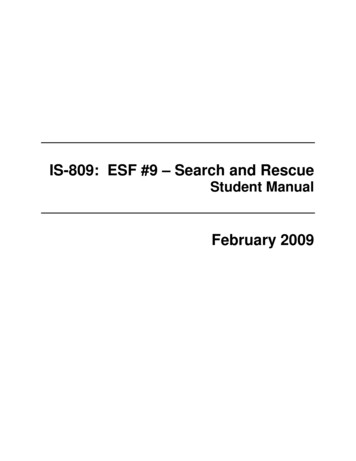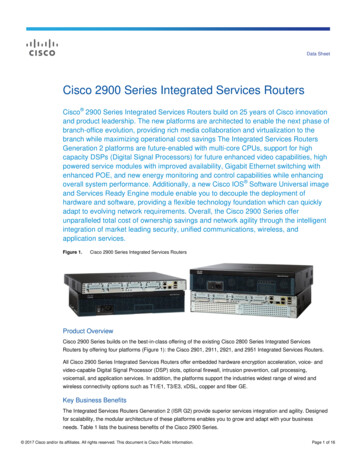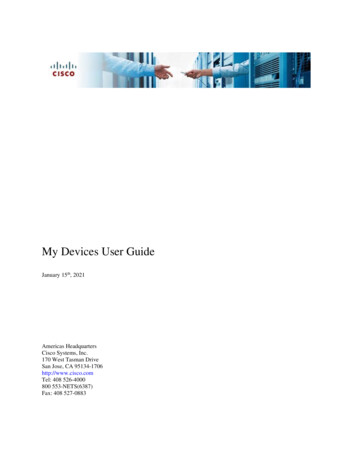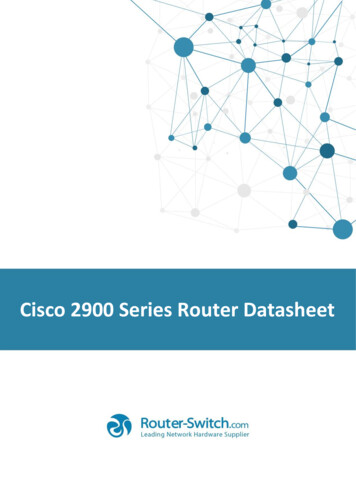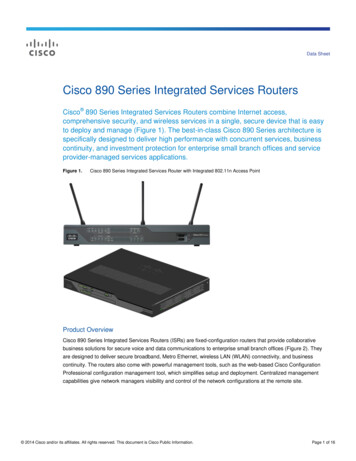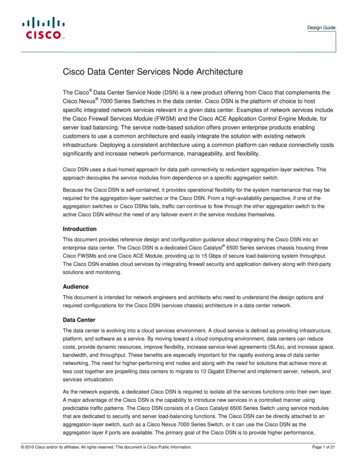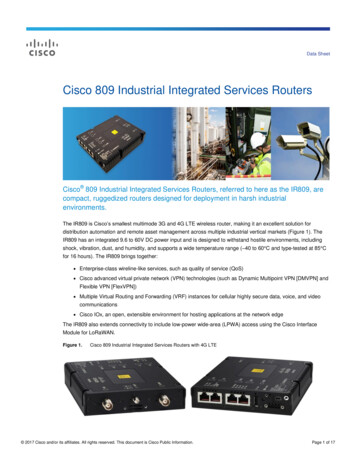
Transcription
Data SheetCisco 809 Industrial Integrated Services RoutersCisco 809 Industrial Integrated Services Routers, referred to here as the IR809, arecompact, ruggedized routers designed for deployment in harsh industrialenvironments.The IR809 is Cisco’s smallest multimode 3G and 4G LTE wireless router, making it an excellent solution fordistribution automation and remote asset management across multiple industrial vertical markets (Figure 1). TheIR809 has an integrated 9.6 to 60V DC power input and is designed to withstand hostile environments, includingshock, vibration, dust, and humidity, and supports a wide temperature range (–40 to 60 C and type-tested at 85 Cfor 16 hours). The IR809 brings together: Enterprise-class wireline-like services, such as quality of service (QoS) Cisco advanced virtual private network (VPN) technologies (such as Dynamic Multipoint VPN [DMVPN] andFlexible VPN [FlexVPN]) Multiple Virtual Routing and Forwarding (VRF) instances for cellular highly secure data, voice, and videocommunications Cisco IOx, an open, extensible environment for hosting applications at the network edgeThe IR809 also extends connectivity to include low-power wide-area (LPWA) access using the Cisco InterfaceModule for LoRaWAN.Figure 1.Cisco 809 Industrial Integrated Services Routers with 4G LTE 2017 Cisco and/or its affiliates. All rights reserved. This document is Cisco Public Information.Page 1 of 17
Product OverviewThe Cisco 809 Industrial Integrated Services Routers support the latest Third-Generation Partnership Project(3GPP) Release 9 Category 3 and Category 4 LTE standards. The routers provide persistent, reliable LTEconnectivity transparent hand-offs between LTE and 3G networks.The following models are available: IR809G-LTE-NA-K9: Multimode 4G, 3G, and 2G connectivity to cellular networks operating in LTE 1900MHz (band 2 PCS), 1700/2100 MHz (band 4 AWS), 850 MHz (band 5), 700 MHz (band 17), and 1900 MHz(band 25 extended PCS) frequencies; backward-compatible with UMTS and HSPA , at 850 MHz (band 5),900 MHz (band 8), 1900 MHz (band 2 PCS), and 1700/2100 MHz (band 4 AWS). IR809G-LTE-VZ-K9: Multimode 4G, 3G, and 2G connectivity to cellular networks operating in LTE 700 MHz(band 13), 1700/2100 MHz (band 4 AWS), and 1900 MHz (band 25 extended PCS) frequencies; backwardcompatible with EVDO Rev A/CDMA 1x BC0, BC1, and BC10. IR809G-LTE-LA-K9: Multimode 4G and 3G connectivity to cellular networks operating in FDD LTE 2100MHz (band 1), 1800 MHz (band 3), 850 MHz (band 5), 2600 (band 7), 900 (band 8), 850 (band18, band19),1500 (band 21), 700 (band 28), and TDD LTE 2600 (band 38), 1900 (band 39), 2300 (band 40), and 2500(band 41); backward-compatible with WCDMA 2100 MHz (band 1), 850 MHz (band 5), 800 MHz (band 6,band 19), 900 MHz (band 8), 1700 MHz (band 9), and TD-SCDMA 1900 MHz (band 39). IR809G-LTE-GA-K9: Multimode 4G, 3G, and 2G connectivity to cellular networks operating in LTE 800MHz (band 20), 900 MHz (band 8), 1800 MHz (band 3), 2100 MHz (band 1), and 2600 MHz (band 7)frequencies; backward-compatible with UMTS and HSPA at 850 MHz (band 5), 900 MHz (band 8),1900 MHz (band 2), and 2100 MHz (band 1).The IR809 routers offer a broad range of features for industrial and enterprise Internet of Things (IoT), as listed inFigure 2.Figure 2.Cisco 809 Industrial Integrated Services Routers Offer a Broad Range of FeaturesLTE connectivity: LTE offers a cost-effective alternative in areas where broadbandservices either are not available or are very expensive.Quality of service (QoS): QoS enables differentiated treatment of traffic for missioncritical services and load balancing for a better user experience.Supervisory control and data acquisition (SCADA) applications: DNP3 serial–to–DNP3/IP translation and IEC 60870 T101–to–IEC 60870 T104 protocol translationserves as a SCADA gateway and Raw Socket transport for managing remote terminalunits (RTUs). 2017 Cisco and/or its affiliates. All rights reserved. This document is Cisco Public Information.Page 2 of 17
Smart-grid compliant: The routers are IEEE 1613 and IEC 61850-3 certified fordistribution automation and secondary substation deployments.Industrial security: Services include area firewall and VPN services, which requireno additional hardware or client software.GPS. The routers support remote tracking asset management in a distributednetwork.Fog computing, management, and automation: Enable remote monitoring andcontrol at the edge and improve process efficiency by moving the intelligence to theedge rather than the cloud.Network management: Tools such as Cisco IoT Field Network Director, CiscoPrime , and Cisco Application Policy Infrastructure Controller Enterprise Module(APIC-EM) simplify deployment of a secure network head end using the CiscoIndustrial Operations Kit.Multiple packet data network (PDN) feature: This feature allows the router toconnect to different access point names (APNs), enabling traffic segregation. Forexample, public Internet traffic can be kept separate from mission-critical trafficemerging from the sensors and devices connected to the router. 2017 Cisco and/or its affiliates. All rights reserved. This document is Cisco Public Information.Page 3 of 17
4G LTE multiple-bearer QoS for cellular: The IR809 supports 4G LTE multiplebearers, enabling differentiated treatment of traffic based on the QoS policies. TheQoS feature depends on a service provider’s ability to classify and enforce QoSpolicies and hence requires providers to launch this service in their networks.Multi-VRF: The IR809 supports the multi-VRF feature, which allows customers toconfigure and maintain more than one instance of a routing and forwarding tablewithin the same customer edge (CE) device. For service providers, this featureenables them to support two or more VPNs, and the IP addresses can overlapseveral VPNs.Business Benefits and Application ExamplesIndustrial customers are looking for real-time monitoring and control of industrial assets to help increase operationefficiency.UtilitiesUtilities are seeking the capability to monitor thousands of miles of electrical or water infrastructure often located inharsh environments through 3G and 4G cellular networks to provide remote assets monitoring and reliable andsecure SCADA traffic backhauling. Devices that enable this connectivity need to be able to be remotely monitoredand configured. They also need to support traditional serial interfaces to interconnect with existing monitoringdevices.Oil and GasOil and gas companies need to monitor pipeline infrastructure across wide geographic areas and remote locationsusing 3G and 4G cellular networks to collect data from remote terminal units and securely transport SCADA trafficto a network operations center (NOC).TransportationHighways and transportation agencies require reliable always-on communication between speed cameras,monitoring cameras, ticket terminals, etc. Wireless devices to support such continuous communication need tosupport 3G and 4G networks to help ensure good, wide coverage; support continuous operation in very harshenvironments; be very compact for deployment in roadside cabinets; and support serial interfaces to existingtraditional devices. 2017 Cisco and/or its affiliates. All rights reserved. This document is Cisco Public Information.Page 4 of 17
Primary Features and BenefitsTable 1 lists the features and benefits of the IR809.Table 1.Features and Benefits of Cisco 809 Industrial Integrated Services RoutersFeaturesBenefitsIoT EnablementCompact ruggedized form factorDesigned for hostile outdoor remote assets monitoring and machine-to-machine (M2M)communications and integrated 9.6 to 60V DC power supply.Raw socket transport and SCADARaw Socket can be used to transport SCADA data from RTUs. This method is an alternative to theBlock Serial Tunnel (BSTUN) protocol. The IR809 provides DNP3 serial–to–DNP3/IP translation andIEC 60870 T101–to–IEC 60870 T104 protocol translation to serve as a SCADA gateway to do thefollowing: Receive data from RTUs (T101 or DNP3 serial) and relay configuration commands from the controlcenter (T104 or DNP3 IP) SCADA applications. Receive configuration commands from the control center and relay RTU data to the control center. Terminate incoming T104 or DNP3 IP requests from the control center when an RTU is offline.Cisco IOx application supportProvides an open, extensible environment for hosting OS and applications at the network edge.IoT field network directorAvailable as an optional Industrial Operations Kit. This software platform manages a multiservicenetwork and security infrastructure for IoT applications such as transportation, smart grid, services,distribution automation, and substation automation.Multiple mounting options Supports a variety of mounting options: floor mount, wall mount, and DIN rail mount.Lightweight, compact size with lowpower consumption Can be deployed in many different environments where space, heat dissipation, and low powerconsumption are critical factors.Increased performance to runconcurrent services Performance allows customers to take advantage of broadband network speeds while runninghighly secure, concurrent data, voice, video, wireless, and IoT services.Enhanced security An integrated stateful and application inspection firewall provides network perimeter security.Hardware-assisted high-speed IP Security (IPsec), Triple Data Encryption Standard (3DES), andnext-generation encryption protocols such as Advanced Encryption Standard (AES) and SecureHash Algorithm (SHA) offer data privacy over the Internet. Intrusion prevention enforces security policies in a larger enterprise or service provider network.Multiple WAN and LAN ConnectionsTwo Gigabit Ethernet interfaces Allows multiple Ethernet device connectivity in a small office or other remote location with thecapability to designate a port as the network edge. Provides VLANs for Layer 3 IP subinterfaces. Provides inter-VLAN routing capabilities.Two serial interfaces These two asynchronous serial interfaces (one RS-232 port and one RS-232/RS485 port) can beused with Raw Socket, protocol translation, and IOx applications to provide two serial connectionsto local RTUs for SCADA transport and RTU management.LoRaWAN Extends IR809 connectivity to include LPWA access using Cisco Interface Module for LoRaWAN.For more information, see rface-modulelorawan.Transparent Roaming Between Wireless NetworksDual subscriber-identity-module (SIM)support The dual SIM feature provides reliability and multihoming capabilities over LTE and HSPAnetworks.Cisco IOS Mobile IP features Mobile IP offers transparent roaming for mobile networks, establishing a transparent Internetconnection regardless of location or movement. This feature enables mission-critical applications tostay connected even when roaming between networks. Assigned IP addresses to the home network are maintained in private and public networks. Both Proxy Mobile IP (PMIPv6) and Network Mobility (NEMO) are supported.Cisco IOS Mobile network features This feature allows an entire subnet or mobile network to maintain connectivity to the homenetwork while roaming.Multiple wireless WAN technologies Users can use the best wireless (4G LTE, 3.7G, 3.5G, 3G, or 2G) technology or network available.IR809G-LTE-LA-K9 does not support 2G. 2017 Cisco and/or its affiliates. All rights reserved. This document is Cisco Public Information.Page 5 of 17
FeaturesBenefitsAdvanced IP Services in Standards-Based Cisco IOS SoftwareAdvanced security features Authorization and authentication determine which individuals and devices have access to thenetwork. Firewall protection provides perimeter security when public networks are used. 3DES and AES encryption provide highly secure VPNs when data is transmitted and received overpublic networks. The next-generation protocol suites enable users to monitor potential malicious activity on thenetwork. IPsec over IPv4 & IPv6, IPsec stateful failover, VRF-aware IPsec, DMVPN, FlexVPN and PMIPv6.Routing Enables advanced routing capabilities using Enhanced Interior Gateway Routing Protocol (EIGRP),Multiprotocol Border Gateway Protocol (MP-BGP), IPv4 and IPv6 on all interfaces includingcellular, IPv4/IPv6 Multicast, Generic Routing Encapsulation (GRE) and multipoint GRE (MGRE),Network Address Translation (NAT), Domain Name System (DNS) proxy and spoofing, IP servicelevel agreement (SLA), and QoS.QoS features Provides traffic precedence to delay-sensitive and mission-critical services. Facilitates low-latency routing of delay-sensitive industrial applications. Supported on all LAN and WAN interfaces including cellular. Provides LTE QoS with support for up to 8 concurrent bearers on each cellular WAN interface fortraffic classification and prioritization.Management and manageability Network managers can remotely manage and monitor networks with Simple Network ManagementProtocol Versions 1, 2, and 3 (SNMPv1, v2, and v3); Telnet; and HTTP/HTTPS and Secure ShellVersion 2 (SSHv2). They can also manage and monitor networks locally through a console port. Support for extensive 3G and 4G LTE-based MIBs allows centralized management of remotedevices and gives network managers visibility into and control over the network configuration at theremote site. Network managers can reset to a predesignated golden image, as well as configure an IR809through Cisco IOS Software or through an external reset button. Network managers can upgrade 3G, 3.5G, 3.7G, and 4G LTE firmware and router configurationsremotely. The tight integration with Cisco IOS Software enables the router to self-monitor the LTE WAN linkand automatically recover from a radio link failure. Network management tools such as Cisco IoT Field Network Director, Cisco Prime, and APIC-EMsimplify deployment of a secure network head end using the Cisco Industrial Operations Kit.Product SpecificationsTable 2 provides 4G LTE specifications for the IR809.Table 2.4G LTE Specifications for Cisco 809 Industrial Integrated Services RoutersRegion -VZ-K9IR809G-LTE-LA-K9BandsLTE bands 1, 3, 7, 8, and20; 800 (band 20), 900(band 8), 1800 (band 3),2100 (band 1), and 2600(band 7) MHzLTE band 2 PCS 1900, band 4AWS (1700/2100), band 17(700), and band 25 extendedPCS 1900LTE band 13 (700), band 4AWS (1700/2100), andband 25 extended PCS(1900)LTE bands 1, 3, 5, 7, 8,18, 19, 21, 28, and 38–41Theoretical download 100 and 50 Mbpsand upload speeds*100 and 50 Mbps100 and 50 Mbps150 and 50 MbpsAustraliaYesNoNoYesEuropeYesNoNoNoMiddle EastYesNoNoNoLatin America(LATAM) and AsiaPacific (APAC)Yes (Please refer to Product Yes (Please refer to ProductApproval Status tool.)Approval Status tool.)NoYes (Please refer toProduct Approval Statustool.)United StatesNoYes (ATT)Yes (Verizon)NoCanadaNoYesNoNo 2017 Cisco and/or its affiliates. All rights reserved. This document is Cisco Public Information.Page 6 of 17
FeatureDescriptionImportant 4G LTE features Single and dual LTE WAN support for WAN redundancy, high reliability, and enhanced throughput LTE QoS with support for up to 8 concurrent bearers on each cellular WAN interface for trafficclassification and prioritization Multiple Packet Data Networks (PDNs) Automatic switchover and failover between primary and backup links IPv4 and IPv6 support Multichannel interface processor (MIP) profile configuration Send and receive Short Message Service (SMS; maximum 160 characters) 4G and 3G MIB with extension and traps Remotely initiated data callback using SMS Remote firmware upgrade over 4G LTE Virtual diagnostic monitoring Mobile equipment personalization (MEP) lock and unlock capabilities SIM lock and unlock capabilitiesDual SIM support High reliability and cellular multihoming support for dual SIM card socket; compliant with ISO-7816-2(SIM mechanical) Capability for the two SIMs to operate in active-backup modeGlobal Positioning System (GPS) SMS Send and receive SMS (maximum 160 characters)MIBs Enhanced 3G MIB with 4G MIB extension (4G LTE parameters are covered with 3G MIB and 3G MIBextension) ENTITY MIB IF MIBGPS antenna: SMA connector (separate active GPS with SMA antenna option)Standalone GPS; needs line of sightConfiguration of multiple profilesAssisted GPS (will be supported in future Cisco IOS Software release) 3G wireless WAN (WWAN) MIB persistence4G LTE network management anddiagnostics In-band and out-of-band management using Telnet (Cisco IOS Software command-line interface [CLI])and SNMP, including MIB II and other extensions Industry-standard 4G LTE diagnostics and monitoring tools (QUALCOMM CDMA Air Interface Tester[CAIT] and Spirent Universal Diagnostic Monitor [UDM]).Programming interfacesWireless technologies supported(performance and throughput) Cisco IOS Software CLIIR809G-LTE-GA-K9Cisco LTE 800 MHz (band 20), 900 MHz (band 8), 1800 MHz (band 3), 2100 MHz (band 1), and 2600 MHz(band 7) at Category 3 LTE speeds1.Backward compatibility: UMTS and HSPA : 850, 900, 1900, and 2100 MHz Quad-band EDGE, GPRS, and GSM: 800, 900, 1800, and 1900 MHz HSPA speed DL up to CAT 20 (42.2 Mbps) and UL up to CAT 6 (5.76 Mbps) DC-HSPA speed DL with CAT 24 (42.2 Mbps) and UL up to CAT 6 (5.76 Mbps)IR809G-LTE-NA-K9Cisco LTE 1900 MHz (band 2 PCS), 1700/2100 MHz (band 4 AWS), and 700 MHz (band 17) at Category 3LTE speeds1.Backward compatibility: UMTS and HSPA : 850 (band 5), 900 (band 8), 1700/2100 (band 4 AWS), 1900 (band 2), and 2100(band 1) MHz Quad-band EDGE, GPRS, and GSM: 800, 900, 1800. and 1900 MHz HSPA speed DL up to CAT 20 (42.2 Mbps) and UL up to CAT 6 (5.76 Mbps) DC-HSPA speed DL with CAT 24 (42.2 Mbps) and UL up to CAT 6 (5.76 Mbps)IR809G-LTE-VZ-K9Cisco LTE 700 MHz (band 13), 1700/2100 MHz (band 4 AWS), and 1900 MHz (band 25 extended PCS) atCategory 3 LTE speeds1.Backward compatibility: EVDO Rev A/CDMA 1x BC0, BC1, and BC10 2017 Cisco and/or its affiliates. All rights reserved. This document is Cisco Public Information.Page 7 of 17
FeatureDescriptionIR809G-LTE-LA-K9Cisco LTE FDD 2100 MHz (band 1), 1800 MHz (band 3), 850 MHz (band 5), 2600 (band 7), 900 (band 8),850 (band18, band19), 1500 (band 21), and 700 (band 28); and TDD LTE 2600 (band 38), 1900 (band 39),2300 (band 40), and 2500 (band 41) at Category 4 LTE speeds1 (peak downlink rate: 150 Mbps; peakuplink rate: 50 Mbps)Backward compatibility: UMTS and HSPA : 2100 MHz (band 1), 850 MHz (band 5), 800 MHz (band 6 and band 19), 900 MHz(band 8), 1700 MHz (band 9), and TD-SCDMA 1900 MHz (band 39)LED indicators for 4G Received-signal-strength indication (RSSI; green) WWAN (green) SIM status (green and yellow) GPS (green and yellow) SYS (green and yellow) VPN (green)1LTE CAT 3 and CAT 4 download and upload speeds depend on specific carrier channel bandwidth and carrier LTE networkprovisioning.Table 3 lists the software features supported on IR809.Table 3.Cisco IOS Software Features on Cisco 809 Industrial Integrated Services RoutersFeatureCisco IOS Software requirementsDescription Cisco IOS Software feature set: Universal Cisco IOS Software image Cisco IOS Software Release 15.6(3)M2 or later and modem firmware Release 5.5.58 or laterIPv4 and IPv6 services features Routing Information Protocol Versions 1 and 2 (RIPv1 and RIPv2) Generic routing encapsulation (GRE) and multipoint GRE (MGRE) Cisco Express Forwarding Standard 802.1d Spanning Tree Protocol Layer 2 Tunneling Protocol (L2TP) Layer 2 Tunneling Protocol Version 3 (L2TPv3) Network Address Translation (NAT) Dynamic Host Configuration Protocol (DHCP) server, relay, and client Dynamic DNS (DDNS) DNS proxy DNS spoofing Access control lists (ACLs) IPv4 and IPv6 multicast Open Shortest Path First (OSPF) Border Gateway Protocol (BGP) Enhanced Interior Gateway Routing Protocol (EIGRP) Virtual Route Forwarding (VRF) Lite Next-Hop Resolution Protocol (NHRP) Bidirectional Forwarding Detection (BFD) Web Cache Communication Protocol (WCCP)Security featuresSecure connectivity Secure Sockets Layer (SSL) VPN for secure remote access Hardware-accelerated DES, 3DES, AES 128, AES 192, and AES 256 Public-key-infrastructure (PKI) support 20 IPsec tunnels Cisco Easy VPN Solution client and server NAT transparency Dynamic Multipoint VPN (DMVPN) Tunnel-less Group Encrypted Transport VPN Flex VPN IPsec stateful failover VRF-aware IPsec IPsec over IPv6 2017 Cisco and/or its affiliates. All rights reserved. This document is Cisco Public Information.Page 8 of 17
FeatureDescriptionCisco IOS Firewall Zone-based policy firewall VRF-aware stateful inspection routing firewall Stateful inspection transparent firewall Advanced application inspection and control Secure HTTP (HTTPS), FTP, and Telnet Authentication Proxy Dynamic and static port security Firewall stateful failover VRF-aware firewallIntegrated Threat Control Control-plane policing (CoPP) Flexible packet matching Network foundation protectionQoS features Low Latency Queuing (LLQ) Weighted Fair Queuing (WFQ) Class-Based WFQ (CBWFQ) Class-Based Traffic Shaping (CBTS) Class-Based Traffic Policing (CBTP) Policy-Based Routing (PBR) Class-Based QoS MIB Class of service (CoS)–to–differentiated services code point (DSCP) mapping Class-Based Weighted Random Early Detection (CBWRED) Resource Reservation Protocol (RSVP) Real-Time Transport Protocol (RTP) header compression (cRTP) Differentiated Services (DiffServ) QoS preclassify and prefragmentation Hierarchical QoS (HQoS)Management features Cisco IoT Field Network Director and Industrial Operations Kit Cisco Application Policy Infrastructure Controller Enterprise Module (APIC-EM) Cisco Universal Plug and Play (UPnP)1 Cisco Configuration Professional Express1 Cisco Configuration Engine support Cisco AutoInstall IP service-level agreement (IP SLA) Cisco IOS Embedded Event Manager (EEM) Telnet, SNMPv3, SSH Protocol, CLI, and HTTP management RADIUS and TACACS Cisco Prime Jasper Control centerHigh-availability features Virtual Router Redundancy Protocol (VRRP) (RFC 2338) Hot Standby Router Protocol (HSRP) Multigroup HSRP (MHSRP) Dual SIM support for cellular failoverIPv6 features IPv6 addressing architecture IPv6 unicast and multicast forwarding IPv6 ACLs IPv6 over cellular IPv6 routing IPv6 domain name resolution1Future Cisco IOS Software release. 2017 Cisco and/or its affiliates. All rights reserved. This document is Cisco Public Information.Page 9 of 17
Table 4 lists the system specifications, and Table 5 lists antenna specifications for the IR809.Table 4.System Specifications for Cisco 809 Industrial Integrated Services RoutersFeatureSpecificationMemoryDefault and maximum DRAM2 GBDefault and maximum flash memory4 GBIP ratingIP30Interface SupportConsole Mini type-B USB; also supports remote 4G LTE diagnostics and monitoring toolsWAN interfaces WWAN with multimode 4G LTE, 3.7G, 3.5G, 3G, and 2G speeds; IR809G-LTE-LA-K9 does notsupport 2GLAN and WAN interfaces Two 10/100/1000BASE-T Gigabit Ethernet portsLEDs System OK (green and amber) WWAN (green) Speed and link for Gigabit Ethernet WAN port (green) Speed and link for all Fast Ethernet LAN ports (green)Serial interface 1 RS-232 and 1 RS-232/RS-485 Support for asynchronous mode with speed up to 115,200 baudSerial protocol support SCADA, DNP3, T101-104, Raw Socket TCP and UDP, and SLIPPhysical CharacteristicsPhysical dimensions (H x W x D)1.15 x 5.05 x 6.27 in. (29.21 x 128 x 159.2 mm)Weight1 lb 11 oz. (0.77 kg)Mounting optionsPanel and door and DIN rail mountMean time between failure (MTBF;ground benign)440,000 hours or morePlatform power consumptionIdle 12WTypical 15WMaximum 19WEnvironmental operating temperaturerange–40 to 140 F (–40 to 60 C) in a sealed NEMA cabinet with no airflow–40 to 158 F (–40 to 70 C) in a vented cabinet with 40 linear feet per minute (LFM) of air–40 to 167 F (–40 to 75 C) in a forced air enclosure with 200 LFM of airType tested at 85 C for 16 hoursOperating altitudeStandard safety certifications50ºC up to 5000 ft (above 5000 ft derate maximum operating temperature 1.50 C per 1000 ft)Maximum altitude: 10,000 ft UL 60950-1, 2nd edition CAN/CSA C22.2 No. 60950-1, 2nd edition EN 60950-1, 2nd edition CB to IEC 60950-1, 2nd edition with all group differences and national deviationsHazardous locations standards ANSI/ISA 12.12.01 (Class 1, Div 2 A-D) CSA 213 (Class 1, Div 2 A-D) IEC 60079-0 and -15 IECEx test report (Class I, Zone 2, gas groups IIC) EN 60079-0 and -15 ATEX certification (Class I, Zone 2, gas groups IIC)Industry standards IEC 61850-1 IEEE 1613EMC emissionsFCC 47 CFR Part 15 Subpart C Class AEN 55032/CISPR 32 Class A, EN 55022 Class AVCCI Class A, AS/NZS CISPR 32 Class ACISPR 11 Class A, ICES 003 Class A, CNS 13438 Class AKN 32 Class A, EN 300 386 2017 Cisco and/or its affiliates. All rights reserved. This document is Cisco Public Information.Page 10 of 17
FeatureSpecificationEMC immunityCISPR 35, EN 55024KN 35EN 61000-4-2, 3, 4, 5, 6, 8, 9, 16, 17, 18, and 29Radio cellularAS/NZS: ACMA EMR, and AS/CA S042.1 and 4Japan: Articles 2 and 9EN 301 489-1, 7, 24, and 52EN 301 908 -1, 2, and 13EN 301 511EN 50385 MPEFCC 47 CFR Part 22FCC 47 CFR Part 15 Subpart CFCC 47 CFR Part 2 MPERSS 102/247Power specificationsMinimum and maximum voltage: 9.6 to 60V DC inputMaximum and minimum current: 2A (9.6V DC) and 0.4A (60V DC)Table 5.Antenna Specifications for Cisco 809 Industrial Integrated Services RoutersItemSpecificationANT-3-4G2G1-ODescription: Cisco transportation omnidirectional 3-element antenna for 2G, 3G, and 4Gcellular and GPS MIMO 2 x cellular elements and 1 x GPS active antenna Vehicular roof stud/nut mounting, qualified to vehicular shock and vibe standards IP67 waterproof with proper installation on the roof on an 8 x 8” flat mounting surface Covers 2G, 3G, and 4G cellular bands in 698-2700 MHz frequency range LTE MIMO support with low correlation coefficient Low-noise active GPS antenna Specifications that follow are given with 1-foot diameter ground plane under antennaCellular electrical specifications (specifications apply to both elements): Frequency ranges: 698 to 960 MHz and 1710 to 2700 MHz Typical gain (dBi): 698 to 960 MHz 2.6 dBi, and 1710 to 2700 MHz 4.6 dBi Efficiency: 60% Polarization: Linear and vertical Port impedance: 50 ohms Voltage standing wave ratio (VSWR): 2.1:1 (698 to 960 MHz) and 2.0:1 (1710 to 2700 MHz) Radiation pattern: Omnidirectional Integrated RF cables: 2 ft, LMR-195 type, TNC (male)GPS electrical specifications: Frequency range: 1575.42 MHz /–1 MHz (GPS L1) Amplifier gain: 27dB /–3dB Noise figure: 4dB max Port impedance: 50 ohms Output VSWR: 2.0:1 Radiation pattern: RHCP DC voltage: 2.7–12V DC DC current: 20 mA over –40 to 85 C temperature range Integrated RF cable: 17 ft, LMR-100 type, SMA(m)Mechanical and environmental specifications: Mount style: Vehicular roof or similar; stud and nut mount Environment: Outdoor, vehicular roof, transportation ruggedized and qualified to subset ofSAE1455 and MILSTD 810G Connectors: 2 x TNC(m) cellular and 1 x SMA(m) GPS Antenna dimensions: 7.1 in. diameter x 2.4 in. height (18.0 x 6.5 cm), excluding RF cables Weight: 1.48 lb (0.67 kg) Operating temperature range: –40 to 70 C Storage temperature: –40 to 85 C Maximum power: 10W Radome: Polycarbonate, UV, black Material substance compliance: ROHS compliant 2017 Cisco and/or its affiliates. All rights reserved. This document is Cisco Public Information.Page 11 of 17
ItemSpecificationANT-4G-OMNI-OUT-N1Description: Cisco outdoor omnidirectional antenna for 2G, 3G, and 4G LTE cellular UV-stable radome Mast-mounting bracket Applicable for both 2G and 3G solutions Domestic LTE 700 band and global LTE 2600 band Domestic cellular and global GSM WiMAX 2300 and 2500Electrical specifications Frequency ranges: 698 to 960 MHz, 1710 to 2170 MHz, and 2300 to 2700 MHz Nominal gain (dBi): 698 to 960 MHz 1.5 dBi, and 1710 to 2700 MHz 3.5 dBi 3 dB beam width (E plane): 698 to 960 MHz 81 degrees, 1710 to 2170 MHz 75 degrees, and2300 to 2700 MHz 100 degrees 3 dB beam width (H plane): 360 degrees, omnidirectional Polarization: Vertical and linear Normal impedance: 50 ohms VSWR: 2.5:1 (698 to 960 MHz) and 2.0:1 (1710 to 2690 MHz) Radiation pattern: OmnidirectionalMechanical specifications Mount style: Mast mount, upright position only Environment: Outdoor Connector: N-type socket Antenna length (height): 9.8 x 1 in. (24.9 x 2.45 cm) Weight: 1.5 lb (0.68 kg) Dimensions (H x Outside dimensions): 9.8 x 1 in. (248 x 24.5 mm) Operating temperature range: –22 to 158 F (–30 to 70 C) Storage temperature: –40 to 185 F (–40 to 85 C) Maximum power: 20W Radome: polycarbonate, UV, white Material substance compliance: ROHS compliant1ANT-4G-PNL-OUT-NDescription: Cisco multiband panel outdoor 4G LTE antenna Supports 3G and 4G LTE solutions Supports bands Wall mount and mast mount Indoor and outdoor Dual type-N socket connectorElectrical specifications Frequency ranges: 698 to 960 MHz and 1710 to 2700 MHz VSWR: 2.0:1 maximum Gain: 8.0 to 10.0 dBi (698 to 960 MHz) and 6.0 to 9.5 dBi (1710 to 2700 MHz) 3 dB beam width (vertical plane): 55 to 70 degrees 698 to 960 MHz, 53 to 98 degrees 1710 to2200 MHz, 60 to 70 degrees 2200 to 2500 MHz, and 55 to 70 degrees 2500 to 2700 MHz 3 dB beam width (horizontal plane): 55 to 70 degrees 698 to 960 MHz and 50 to 90 degrees 1710 to 2200 MHz F/B ratio: 15 dB, typical 20 dB 698 to 960 MHz; and 17 dB, typical 23 dB 1700 to 2700MHz Isolation: 30 dB Polarization: slant /–45 degrees Nominal impedance: 50 ohms Radiation pattern: DirectionalMechanical specifications Mount style: Wall or mast mount Environment: Outdoor Connector: Dual type-N femal
Cisco 809 Industrial Integrated Services Routers, referred to here as the IR809, are compact, ruggedized routers designed for deployment in harsh industrial environments. The IR809 is Cisco’s smallest multimode 3G and 4G LTE wireless


